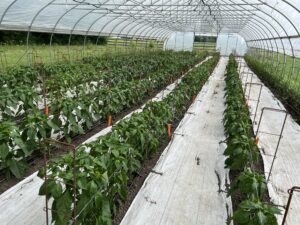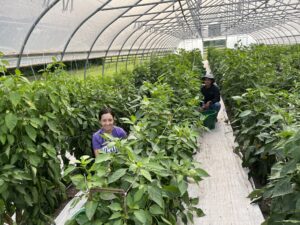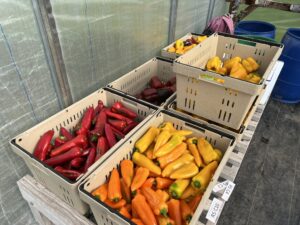Collaborators: Petrus Langenhoven, Lian Duron, Eduardo Miranda, Purdue University, Department of Horticulture and Landscape Architecture
Colored sweet bell-shaped and tapered peppers are a staple at the farmers’ market. Many small and medium-sized farming operations in Indiana grow this summer crop. High tunnels allow growers to protect their crops and extend their growing season. Sweet peppers, in particular, benefit from the unique growing environment created by the high tunnel. Planting of peppers can start at least 2-4 weeks earlier in the spring, and production can continue into the fall until the first hard freeze. Pepper variety performance data for Indiana is not readily available. We are working hard to change that. Currently, we have evaluated twenty-five pepper varieties, and each variety is assessed in two production cycles. This paper reports on five sweet bell and five tapered pepper entries (Table 1) evaluated at the Purdue Student Farm, West Lafayette, Indiana.
Table 1. Colored sweet bell and tapered pepper cultivar characteristics*.
| Cultivar | Type | Days to Maturityz | Immature Fruit Color | Mature Fruit Color |
| PS 09941819 (with X5R®) | Bell Pepper | 86 | green | red |
| Regulator | Bell Pepper | 86 | green | red |
| Turnpike (with X5R®) | Bell Pepper | 87 | green | red |
| Flavorburst | Bell Pepper | 87 | lime green | golden yellow |
| Sweet Sunrise | Bell Pepper | 85 | green | yellow |
| Yellow Crest | Tapered Pepper | 70 | green | yellow |
| Carmen | Tapered Pepper | 80 | green | red |
| Gatherer’s Gold | Tapered Pepper | 90 | green | golden orange |
| Oranos | Tapered Pepper | 75 | green | orange |
| Red Sword | Tapered Pepper | 70 | green | red |
*Data obtained from seed company listed information
z Days to maturity from transplanting to mature fruit color
Materials and Methods
The trial was conducted on a Mahalasville (Md) silty clay loam. The spring soil test showed 7.0% organic matter, pH 7.2, and 145 ppm phosphorus (P), 156 ppm potassium (K), 736 ppm magnesium (Mg), and 3895 ppm calcium (Ca). The cation exchange capacity was 26 meq/100 gram. Nitrogen, 110 lb./A N from Sustane® 8-2-4 (OMRI listed) and pelletized organic alfalfa meal 2.7-0.5-3.0 (Ohio Earth Food) was applied pre-plant, and Nature’s Source® 10-4-3 was applied by fertigating 15 lb./A N at six and eight weeks after transplanting.
The trial was set up in a 30-foot (W) by 96-foot (L) high tunnel (Nifty Hoops, MI) as a randomized complete block design with six replications (Fig. 2-4). The high tunnel was equipped with louvered gable vents (one at each end wall) and roll-up sidewalls. The louvered aluminum vents open automatically at approximately 65-75 °F with a temperature-controlled wax cylinder, and the side walls were opened when inside temperatures reached 75 °F and closed when temperatures dropped below 60 °F. Sweet pepper entries were assigned to individual plots containing one row of five plants that were 7.5 feet long. Peppers were seeded on April 8, 2022, and transplanted on May 18, 2022, with an in-row spacing of 1.5 feet and between-row spacing of 4 feet. (7,260 plants per acre). The walkways between the rows (4 feet center-to-center) were covered with a black woven polypropylene ground cover (DeWitt SunbeltTM). Additionally, a 3 feet wide white woven polypropylene ground cover was placed between the rows to increase light in the lower plant canopy. Irrigation was applied daily using drip tape (Rivulis T-tape 5/8″) with a 12″ emitter spacing and flow rate of 0.22 GPM/100 feet. Two drip tape lines were used per row, with the emitters positioned diagonally from one another. This ensures even soil moisture distribution along the planting row. Irrigation volume was increased according to plant growth, soil, and climatic conditions.
Peppers were trellised using the HD trellis support (8 inches wide, 37 inches high plus 13-inch-long legs at the base, Nolts Produce Supplies LLC, PA) and trellis twine (Fig. 3 and 4). No pruning was done during the growing season. In addition to the HD trellis support, two varieties, Oranos and Red Sword were trellised using tomato trellis twine and clips (Johnny’s Selected Seed). About four stems per plant were trellised six feet high. Weed control was minimal and done by hand. Yellow and blue sticky cards were used for scouting and monitoring and to attract and capture the adult life stage of insect pests. Pest pressure was very low; therefore, no foliar pesticide applications were made during the growing season.
Each plot was harvested after the peppers reached their mature color. Harvesting continued once a week between 79 and 149 days after transplanting. For each plot, the marketable and unmarketable number of fruit and fruit weight were recorded weekly, and fruit size (length and width) was recorded with an electronic digital caliper (VINCA DCLA-0605) at the third harvest (86 days after transplanting). Fruit size data was collected from ten fruit of each variety. Fruit width was measured on the widest part of the shoulder, and fruit length was calculated from the top of the shoulder to the bottom of the fruit. During the last harvest, October 14, 2022, all mature colored and mature green fruit were harvested and recorded. The marketable yield was expressed as yield per plant or yield per acre. Data were analyzed using ANOVA followed by treatment means separation using Tukey-Kramer’s least significant difference at P≤ 0.05.
Results
Marketable Yield
Marketable fruit yield and weight results are presented in Table 2. Data show significant statistical differences for marketable fruit count per plant, the number of marketable fruits per acre, fruit weight, and yield differences among entries. During this evaluation, Oranos (44.3) and Carmen (35.8) produced the most fruits per plant and acre, significantly higher than the other tapered or bell-shaped pepper entries. The fruit yield per plant of tapered pepper entries Yellow Crest (22.2) and Red Sword was 47% and 25%, respectively, lower than in 2021 (Langenhoven, 2021).
This season four new bell pepper variety entries were included in the evaluation. Fruit yields ranged between 17.5 (Sweet Sunrise) and 11.0 (Turnpike) per plant. Flavorburst fruit yield (16.3) did not differ significantly from Sweet Sunrise and is in line with results obtained in 2020 and 2021.
The tapered pepper variety Carmen produced the highest fruit yield (9.3 lb) per plant, significantly higher than other tapered pepper entries, Oranos (6.8 lb), Yellow Crest (6.7 lb), and Gatherer’s Gold (6.5 lb). There is no significant difference in the production of Carmen (9.3 lb), Red Sword (8.6 lb), and all the bell pepper variety entries. Gatherer’s Gold produced the lowest fruit yield per plant.
Again, fruit from bell pepper entries was significantly heavier. Turnpike (11.5 oz) and PS 09941819 (11.4 oz) produced the largest fruit. Flavorburst fruit weight (7.2 oz) was the lowest of all the bell pepper entries, but it was consistent with results obtained in 2020 and 2021(Langenhoven, 2021). Fruit from tapered pepper varieties was significantly lighter, and like in 2021, Gatherer’s Gold (3.4 oz) and Oranos (2.5 oz) produced the lowest average fruit weight.
Fruit Characteristics
Bell and tapered pepper fruit characteristics (length, width, and shape) were recorded. The tapered pepper variety entry Red Sword (8.2 inches) was significantly longer than the other. Oranos produced the smallest tapered pepper (5.1 inches). As expected, the tapered varieties had longer fruit than the bell pepper varieties.
PS 09941819 (4.7 inches) produced the longest bell pepper fruit. As expected, bell peppers were significantly wider at the shoulder, the rounded part of the pericarp just below the calyx, than tapered peppers. Bell pepper fruit width varies between 3.1 and 3.9 inches in contrast to tapered peppers, which are between 1.7 and 2.5 inches. All tapered and bell pepper entries were classified as elongated (ratio ≥1.05).
Unmarketable Yield
Tapered pepper varieties produce more unmarketable fruit per plant, except for Oranos (2.8). Fruit culls resulted from blossom end rot (BER), small cracks on the shoulder, the sides or the blossom end of the fruit, and other fruit defects. Tapered pepper entries Yellow Crest (9.7), Gatherer’s Gold (7.4), Red Sword (6.3), and Carmen (5.2) produced the highest number of culls. The high cull number of Yellow Crest results from an increased number of fruits affected by BER, 7.1 per plant. This contrasts with results from the 2021 season, where the incidence of BER was very low (Langenhoven, 2021).
Bell pepper cull numbers were very low, between 1.3 and 2.8, and did not differ significantly. In general, a high percentage of the total culls was the result of BER. Tapered pepper entries Yellow Crest (65.6%), Red Sword (53.6%), Carmen (45.0%), and bell pepper entries PS 09941819 (30.6%) and Sweet Sunrise (28.4%) had a significant percentage of their unmarketable culls as BER culls. Tapered variety Oranos (6.4%) had the lowest rate of BER fruit.
The unmarketable yield of Yellow Crest (2.1 lb per plant) was significantly higher than most other varieties. Turnpike had some BER (0.2 fruit per plant), but most culls were affected by cracks on the fruit’s shoulder, side, and blossom end. Oranos produced the lowest unmarketable yield (2295 lb./A).
Discussion
All entries, except Yellow Crest, performed well. Compared to 2021, Yellow Crest yield was reduced by 3.2 lb per plant. That is mainly due to a six-fold increase in fruit affected by BER (Langenhoven, 2021). This might result from a higher nitrogen application rate and extreme summer temperatures.
The HD trellis support system was adapted to cater to vigorous varieties such as Red Sword (red bell pepper) and Oranos (tapered orange pepper). Offering additional trellis support to these varieties improved yield slightly for Oranos. However, the Red Sword yield was lower due to a higher incidence of blossom end rot. The trellis system makes it easier to harvest the fruit and prevents the stems from snapping off. Maintaining the trellised plants requires additional labor and resources.
All tapered pepper entries consistently showed an increased incidence of BER, except for Oranos (Langenhoven, 2021). In fact, Oranos produced less BER-affected fruit in 2022. Oranos is a very sweet, bright orange pepper with exceptional flavor and is a prolific producer (321,376 fruit/A). Red Sword fruit is sweet, has a vibrant red color, and is very firm and thick-walled. Fruit size and shape are consistent, and it is a high-producing variety (62,314 lb./A). Carmen, the tapered pepper industry standard in this variety trial, reclaimed its position as the top tapered pepper variety (67,345 lb./A).
Exciting new bell pepper entries included Regulator (red) and Sweet Sunrise (yellow). Sweet Sunrise produced the highest number (127,232 fruit/A) of medium-sized (6.4 oz) bright yellow fruit of all the bell pepper entries. Regulator had fewer fruit (96,316/A), but the fruit was very firm and larger (9.2 oz). Flavorburst, our bell pepper industry standard, is a consistent performer, producing 118,641 fruits with a net weight of 53,814 lb./A. This variety is the least affected by BER. PS 09941819 and Turnpike produced large to jumbo-sized fruit (11.4 and 11.5 oz, respectively). PS 09941819 had the highest yield of all the bell peppers. However, Turnpike’s production was affected by higher cull numbers due to fine cracks in the fruit.
It would be interesting to see how these bell pepper varieties perform in 2023. In addition to Carmen, we will include four new tapered pepper varieties in the 2023 trial.
Acknowledgments
Chris Adair and Purdue Student Farm summer interns and students who provided on-farm support.
References
Langenhoven, P. 2021. Colored Sweet Bell and Tapered Pepper Cultivar Evaluation for High Tunnel Production in West-Central Indiana, 2021. Midwest Variety Trial Report. Accessed on December 14, 2022.
More information about this report
Visit the Midwest Variety Trial web page for more information and pictures.


